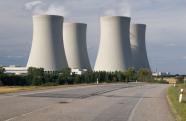Where will Nuclear Waste Go?
What Japan may teach us

The tsunami that disabled the Japanese Fukushima is empowering the nuclear energy community in the United States. A panel of concerned interests appointed by the president before the accident is recommending a new and permanent repository to store spent fuel.
While the commission did not name a specific location, its move is an interesting one: It points to the need to have central positions where the mega waste created by nuclear plants can go. But it would also appear to be a near-futile effort, given that billions have already been paid to get an earlier iteration off the ground -- an effort that died after years of work.
Two years ago, the Obama administration pulled the plug on Yucca Mountain that is about 90 miles outside of Las Vegas. It had pointed to engineering concerns that it said would be too costly to fix, saying that experts had said that ground water could leak into where the spent fuel rods would be stored. Others, though, say that the motives were purely political, noting that the president was trying appease the state’s voters as well as then-Majority Leader Harry Reid of Nevada.
The most recent study is headed by former National Security Chief Brent Scowcroft and former Democratic representative Lee Hamilton. “A new strategy is needed, not just to address these damages and costs but because this generation has a fundamental ethical obligation to avoid burdening future generations with the entire task of finding a safe permanent solution for managing hazardous nuclear materials they had no part in creating,” says their report.
The blue ribbon panel that has 15 members in all is suggesting that authority for such a decision be given exclusively to a “new organization” that is empowered to succeed. It also says that some interim storage facilities could be consolidated, or that multiple, fresh sites could house the spent fuel.
At present, 120 nuclear waste storage facilities exist in 39 states. Altogether, they hold 60,000 tons of spent fuel. Committee members have told other news outlets that New Mexico may present an optimal location, given its geology as well as its understanding and experience with the nuclear industry.
Pricey Solutions
The panel also acknowledges that this pursuit will be pricey but emphasizes that U.S. taxpayers are already paying for waste disposal through fees collected on each kilowatt of nuclear power currently generated.
Right now, nuclear waste is stored in steel-encased caskets that are above ground. Such sites were always meant to be temporary. And while some utilities are taking legal action to retrieve the roughly $15 billion to $20 billion in fees paid since 1982 to develop Yucca Mountain, others are more reticent and want to focus on the revival.
Still, the commission says, “Overall, we are confident that our waste management recommendations can be implemented using revenue streams already dedicated for this purpose.”
Beyond the issue of storage is the idea of reprocessing spent fuel. Reprocessing, now prevalent in France and Japan, separates the uranium and the plutonium from the rest of the nuclear waste. Nuclear operators would then be able to get between 20 percent and 30 percent more use from the uranium, say some experts, who argue that the technology is real and that concerns over proliferation of weapons-grade material can be effectively addressed.
The U.S. Nuclear Waste Technical Review Board is considering the issue. While the concept has its foes who say that it is expensive and a potential goldmine for rogue nations, others say that it is necessary and unavoidable. But the board admits that reprocessing has an uncertain future here, saying that while the technology may reduce such waste it does not eliminate it.
“While some supporters of a U.S. reprocessing program believe it would help solve the nuclear waste problem, reprocessing would not reduce the need for storage and disposal of radioactive waste,” adds the Union of Concerned Scientists. “Worse, reprocessing would make it easier for terrorists to acquire nuclear weapons materials, and for nations to develop nuclear weapons programs.”
So, the question for now centers on finding both the funding and the location for a new central repository, or a series of them. For those who argue that this has already been done, they would be right. Despite their exasperation, there does not seem to be a better idea if the nuclear industry wants to regain its legs.
EnergyBiz Insider has been named Honorable Mention for Best Online Column by Media Industry News, MIN. Ken Silverstein has also been named one of the Top Economics Journalists by Wall Street Economists.
Follow Ken on www.twitter.com/ken_silverstein
energybizinsider@energycentral.com.
Copyright © 1996-2011 by CyberTech, Inc. All rights reserved.
To subscribe or visit go to: http://www.energycentral.com